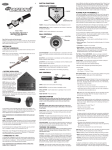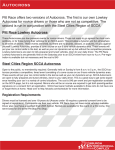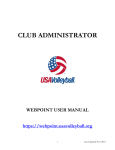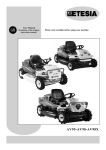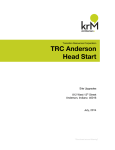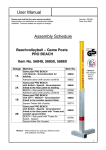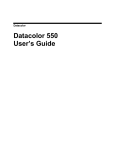Download A Guide To Volleyball Basics
Transcript
A Guide To Volleyball Basics by Jim Paglia Published by Sporting Goods Manufacturers Association Edited with Sandy Briggs TABLE OF CONTENTS Welcome to the Game of Volleyball Page 3 History of Volleyball Page 4 Evolution of USA Volleyball Page 4 The Olympic Pinnacle is Reached in 1964 Page 4 The Court Page 5 Poles, Net & Standards Page 5 The Ball Page 6 Apparel Page 6 Volleyball Variations Page 7 Newcomb Page 7 Recreational Page 7 Four-a-Side Page 7 Wallyball Page 8 Doubles Page 8 Coed Page 8 Beach Page 8 Volleyball Fundamentals Page 9 Passing Page 9 Setting Page 10 Hitting Page 11 Serving Page 12 Individual Defense Page 13 Digging Page 13 Blocking Page 14 Rules of Volleyball Page 15 Referee's Signals Page 21 Basic Offense Page 22 Basic Defense Page 24 Volleyball Glossary Page 25 Game Situations Page 27 Volleyball Web Sites Page 28 2 WELCOME TO THE GAME OF VOLLEYBALL! This guide is intended to help you attain a basic understanding of the game of volleyball. You may wish to keep this booklet handy and refer to it often as you become more comfortable with the rules, procedures, and customs of volleyball. Get out and play. The more you play, the more you'll improve. Even the "backyard warrior" who doesn't intend to go beyond the occasional recreational game needs to be familiar with the basics. If you tend to play infrequently, or you're just getting into the game, you'll find it helpful to briefly skim this booklet before each volleyball outing. Soon, the rules, terminology, and various hand signals will become second nature to you. Your skills and confidence will grow rapidly once you've mastered the basics. You can also learn a great deal by watching others. Study other players' techniques and team tactics. Look to get games against better players and don't hesitate to ask a teammate lots of questions. Even the most experienced players know that communication both on and off the court makes for better volleyball. 3 HISTORY OF VOLLEYBALL Volleyball Borrows from America's Favorite Sports to Create a Unique Challenge and History In 1895 an instructor at the Young Men's Christian Association (YMCA) by the name of William Morgan decided to blend elements of basketball, baseball, tennis and handball to create a game for his classes that would demand less physical contact than basketball. The "Y" took this new game around the world and introduced a uniquely American sport to many foreign lands. In 1916, the Philippines made its own contribution to volleyball by introducing an element of offense that would forever change the game. A receiving player would pass a ball in a high trajectory that would then be struck by another player. The set and spike were born. EVOLUTION OF USA VOLLEYBALL It became clear by 1928 that tournaments and rules were needed and The United States Volleyball Association (USVBA) was born. Now, USA Volleyball (USAV), formerly USVBA, is the National Governing Body (NGB) for the sport and the parent organization of the USA Men's and Women's National Teams. As such, USAV is recognized by the Federation Internationale de Volleyball (FIVB), the international governing body of volleyball. It is USAV's mandate to nurture all variations of the game indoor, beach, grass, six-person, doubles, coed, disabled (sitting and standing) - at all skill and age levels. USAV responsibilities include supporting a year-long training schedule for the Men's and Women's National Teams; USA Youth Volleyball (ages 7-12); the Junior Olympic Volleyball program (ages 1218); Junior Olympic Beach Volleyball (ages 12-18); U.S. Open Championships by age groups for both indoor and beach; the USA Coaching Accreditation Program (CAP); establishing rules of play in the United States; and certifying referees and scorekeepers. All of these activities are implemented through a predominantly volunteer work force headed by thirty-eight regional commissioners and the support of 26 USAV member organizations (i.e., the YMCA, Police Athletic League, National Collegiate Athletic Association, American Volleyball Coaches Association, et al.). There are more than 46 million Americans who play volleyball. THE OLYMPIC PINNACLE IS REACHED IN 1964 This truly American game was first introduced to Olympic competition at the Tokyo Games of 1964. The U.S. won its first medals in the 1984 Los Angeles Olympics when the men captured the gold and the women the silver. Why did it take us twenty years to win an Olympic medal in a sport we invented and introduced to the world? Simple, Americans were slow to take up the game at its most competitive level, and those people who did take up the game just didn't bother to adhere to standardized rules. Now you should have a better understanding of how and why this booklet was created. We hope it will serve you well to better understand the rules, various elements and customs of the game and we trust that you will derive as much satisfaction from the game as it has provided millions of others over the years. 4 THE COURT The court diagram at the right shows the official USA Volleyball indoor specifications. The official court dimension is 9 meters by 18 meters with an attack line 3 meters from the center line. Most U.S. outdoor and recreational courts use a net that is 32' x 3' and a court of 30' x 60' with a 10' attack line on indoor courts. POLES, NET & STANDARDS Materials: Metal - Wood - Plastic 2" - A double thickness of white canvas or vinyl 5 cm (2") shall be sewn along the full length of the top of the net. 32' x 3' - The net shall be not less than 9.50 m (32') in length and .91 m (3') in width throughout the full length when stretched 7' 11 5/8" - The height of the net measured from the center of the court shall be 2.43 m (7'11-5/8") for men. 7' 4 1/8" - The height of the net measured from the center of the court shall be 2.24 m (7'4 1/8) for women. These are the dimensions of institutional/U.S. tournament and recreational nets. 5 THE BALL 9-10 oz. - The ball shall weigh between 9 and 10 oz. (260-280 grams) and shall have 12 or more pieces that measure 25.5"-27" (62 cm-68 cm). The ball pressure must be between 4.3 and 4.6 lbs. (0.30 and .325 kg/cm2) There is a special "lite" ball for 12 & under kids programming which includes the U.S. Junior Olympic Volleyball Championships run by USAV. The lite ball is the same size and pressure, but has a weight of 7 to 8 oz. (198-227 grams) and has a special "softer" synthetic leather cover that is wonderful for ANY beginner. APPAREL Remove all jewelry. No earrings are allowed. Only smooth wedding bands may be worn. Glasses may be worn, but should be secured with a safety strap. Long sleeve shirts/jerseys provide a safer sliding surface and more cushion over the course of a match. Shirts/jerseys should be of a quality that absorbs perspiration and allows the skin to get air. Shorts should offer maximum flexibility and movement. Spandex has been popular among women players for several years. Pads are made to protect knees and hips to help cushion falls, dives and slides. Socks help to absorb perspiration which cuts down on blisters. Tops of socks are often the driest area on a player and serve as makeshift hand towels in a pinch. On hot sand, special sand socks can be worn. The abrasive nature of sand wears out normal socks. While volleyball is played on a basketball court or other hard surface, only volleyball specific shoes offer the perfect support and flexibility for volleyball. Remember, whatever footwear you choose, look for good ankle support for jumping, landing, twisting and diving. Sporting good retailers and mass merchandisers are dedicating expanded shelf space to volleyball equipment. More and more volleyball specific gear is coming on the market. In some cases, such as casual apparel, it serves to make a fashion or social statement, but retailers are also responding to customers' demands for better made, safer, and higher performance volleyball specific goods. It's worth a little time to find a retailer that carries equipment that suits your needs. VOLLEYBALL VARIATIONS Volleyball can be played by nearly anyone. All ages, sizes, and skill levels can find a place to participate. Nearly everyone is familiar with the fundamental principles of the game and that has led to the development of these variations. NEWCOMB Perhaps the least known but simplest version of volleyball is Newcomb. This version is taught to grade school age children to introduce them to volleyball. Adults of limited athletic ability can also enjoy this version. Newcomb is volleyball without the volley. The ball is thrown across the net and caught by an opposing player. If the ball strikes the floor, is touched by more than one player on a side, or goes out of bounds, a point is scored. As players advance, more "touches" per side can be added, up to three. If necessary, the net can be lowered to suit this primary form. It's not uncommon to have ten or more players on a side in Newcomb. Its purpose is to promote the fundamentals, not merely to develop competition. RECREATIONAL This is the level at which most of us are introduced to the game, and at which most of us remain. While regulation is six players per side, the purpose here is to have fun. The key word in recreational volleyball is flexibility. Keep your temper, ego and attitude away from the court. See Diagram (A) for starting position and functions of both defense and offense. FOUR-A-SIDE Whether you're a beginner looking to improve you skills or an experienced player looking to perfect your game, no version is likely to offer more activity and a wider use of your skills than four-a-side. Expect to have to cover more territory, handle the ball more, and get a greater workout. The designated setter plays in the front court, while two outside hitters play in the back court, and only come to the net for blocks and spikes. The fourth player plays deep to cover most of the back court. See Diagram (B). Triples is also a fun choice that excludes the deep center back player. 7 WALLYBALL Around 1979, some enterprising person figured out a novel use for all those racquetball courts around the country. Why not string a volleyball net across the courts and invite teams of two, three, or four to borrow aspects of both volleyball and racquetball? When playing wallyball, the serve is taken from outside the three foot line, and the server can't touch or cross this line until the ball is struck. The ball may go directly over the net or it may be played off one wall either before or after it crosses the net. Neither team may use the back wall. Only the serving team can score points. A point or a change of serve results from the ball striking the floor or an illegal wall, or more than three touches per side. Games are played to 15 and must be won by two points. Rotation is always clockwise regardless of the number of players. Be prepared for a strenuous workout. DOUBLES Only the truly skilled and athletic need apply. It's just you and a partner. In doubles, six-a-side rules apply with the following exceptions: You don't have to rotate. You can cross the center line as long as you don't interfere with your opponent's play. You cannot open hand "tip." Usually, due to the strenuous nature of this version, scoring is to 11, not to 15. Keep in mind that both players go back on defense, and no one gets to park at the net, and both players set and spike for each other. Where you put a shot is much more important than how hard you hit in this game. COED The key consideration in coed is balance. Whether playing with as few as two, or as many as six players per side, it is important to have an equal number of men and women per side. The net is set at men's height. In reverse coed, the net is set to women's height, and the men must spike behind the three meter line. In some areas, if the ball is played more than one time on your side of the net, one of those touches must be by a woman. Also, U.S. rules say, if there are two women at the net, a male may come from the back row to block at the net. BEACH Aside from the fact that you're playing on a soft surface, be prepared to encounter lots of other differences in beach volleyball. For starters, the lines are marked by a cord or rope, and sometimes they're just drawn in the sand. Since there is no center line, there can't be a center line violation unless someone interferes with an opposing player. The official ball is heavier than indoor and is made of 18 panels. It is also customary to under-inflate the ball a little to "deaden" it, which makes it less likely to be affected by wind, spikes, and passes. In beach volleyball, a block counts as one of your three team contacts only if you are playing doubles or triples. You are honor bound to call your own fouls such as contact with the net. If you play to 11, switch sides every four points, or every five points when playing to 15, to be fair about wind and sun conditions. Players must set in the direction they face and open hand tips are not allowed. It is permissible to use the knuckles of a fist. 8 VOLLEYBALL FUNDAMENTALS PASSING In volleyball much is made of the ability to serve because of the personal fitness and deception that can be demonstrated; to set, which is volleyball's answer to the quarterback position of football; to finish a rally with the placement and power of a spike. Perhaps the least recognized and most critical element of volleyball is the pass. In recreational volleyball it is the greatest moment of confusion because some players are concerned about returning the ball while others are just plain uncertain where that ball is going to go after the first touch. More points are lost on a team's inability to deal effectively with the first ball over the net than at any other point in a game. Most experienced players value a teammate who can pass, as much as they do a good outside hitter and setter. The reason is simple. A good pass will transform your team from a defensive posture to an offensive attack. The most common and effective form of passing is the forearm pass. It's the easiest way to get the ball under control. The only way you can be called for a foul is if the ball rolls up your arms or comes to rest on you arms which will result in a held ball call. The forearm pass is also known as the bump pass. To use it correctly, you must join your hands together and allow the ball to strike the fleshy part of your forearms simultaneously. There many ways of joining your hands, we'll touch on a couple here. But the best way to learn yourself is to watch a few players and experiment. A common mistake is to allow the ball to strike your wrists or hands, often resulting in an unpredictable pass or a ball returned over the net, commonly called an overpass. The best way to avoid this problem is to remind yourself to bend your wrists and hands down before impact to help cushion the ball. Diagram (C). TWO HAND POSITIONS ARE: Wrapped fist - Make a fist with your dominant hand and wrap it in the palm of your other hand, with both thumbs side by side and pointing at the floor. See Diagram (C) above. Cupped palms - Bring your hands together as if you were going to take a sip of water from your hands, and lay your thumbs across the top as in Wrapped Fist position. Some players even like to lock their fingers under their thumbs. See diagram at right at right. 9 Pick the passing method that works best for you. Don't be concerned about which method is better than the other. It's really about personal choice and effective control. Whichever you choose, keep these five points in mind: 1. Keep the ball between your wrists and elbows in the fattest part of the forearm 2. Press the wrists and hands down to hyperextend the arms 3. Lock your elbows. This gives the ball the most area to hit, and helps you control the direction of your pass. 4. Try to bend your knees before the ball gets to you so that you can both absorb the serve and re-direct the pass. 5. Don't swing at the ball, but do try to shrug your shoulders toward your target at the moment of impact. SETTING The setter runs the offense, and determines which hitter to set. Sometimes, a team has two setters. The key to good setting is consistency. The basic premise of setting is to take a bump pass and convert it to a well placed ball that can be effectively hit by another player to the opponent's court. The proper technique for setting is to raise your hands about five inches above your head with your thumbs on the bottom and pointed towards your eyes. You fingers should be loose and slightly cupped. Don't spread your hands any farther than necessary to receive the ball. As a guide, you'll have a two to three inch gap between both of your thumbs and both of your forefingers. Here are a few things to keep in mind about setting: 1. Get to the ball. 2. Face your target (except when you're deliberately making a back set.) 3. Bend your elbows and your knees 4. Look at the ball through the opening between your hands. 5. Bring both hands into contact with the ball simultaneously. 6. Don't let the ball touch your palm. This is called a push, and is a violation. If the ball comes to rest in you hand, or you strike the ball unevenly with either hand, you'll be in violation. 7. Receive the ball over your head, and let it snap out of your finger pads. Keep your hands above your face or you'll be whistled. There are six basic types of sets: One Set - Set a foot or two over the net and hit while the ball is still rising. This is the quickest of sets and is usually for the middle hitter. Two Set - Set two to four feet above the net and is also quick. Again, this ball is usually for the middle hitter. Three Set - Also set low and fast (about 4 - 6 feet above the net and delivered midway between the setter and the sideline). This ball is for either the middle or outside hitter. Six Basic Sets 10 Four Set - A low set (1 - 2 feet above the net) for the outside hitter that is delivered near the sideline and over the net. Sometimes called a "Shoot Set." Five Set - A high Backset near the sideline. Six Set - (fist hand signal) A high outside set to either sideline. Finally, there is a time when the setter gets to try and score. This is called a "setter dump", and is executed when the setter comes to the net but instead of setting, pushes the ball over the net in a "tip" play. HITTING If there is a moment of truth in volleyball, it is the perfectly hit spike. The spike combines power, speed and athleticism to provide the excitement that is uniquely volleyball. The spike is used to either put the ball down in a portion of the court where the opposition is not, or to strike the ball so hard that the defenders are unable to deal with it effectively. Front row players can attack the ball from anywhere on the court. Back row players can only attack from behind the three meter line. Hitters must master such techniques as the: Cross Court Shot - This ball must be hit extremely hard while aiming for a space on the floor between the front row players and the back row player that is diagonally positioned farthest from the hitter. Tip or Dink Shot - The most important aspect of this shot is hitting with a wrist that does not break. Just push or roll the ball with the fingertips over the outstretched hands of the blocker(s). Be sure to face the direction of the dink or a push or carry may be called. Line Shot - The simplest way to describe this shot is to imagine a left outside hitter who is righthanded receiving a set from her right side, rotating her body as she drops her left shoulder, and aiming the ball for the left sideline. Soft Top Spin Shot - Commonly called a "roll shot" or off-speed attack, this ball is contacted a little softer and on the lower portion of the ball. The players hand then rolls over the top of the ball. This action creates top spin which causes the ball to drop quickly, usually just behind the front line players. Hitting combines various elements of technique. Your approach to the net, speed, planting of feet, jumping, timing, body position, and distance from the net are among the factors that contribute to the success of your hit. If you're experiencing difficulty in any aspect of your hit, or repeatedly making an error, ask a qualified instructor to study your form and make suggestions. 11 SERVING Sooner or later, every player will end up in the right back position and be required to put the ball in play. Your serving options are: The Underhand Serve - Since this is the easiest serve to execute, don't be embarrassed to use it in novice or recreational situations. The goal of any serve is to get the ball in play. Sure, we all like to hit an "ace" that rockets across the net, but the first obligation is to maintain serve. The technique is to gently toss the ball up and in front of yourself while bringing the other hand forward to make contact. A simple toss of several inches will suffice. Make contact with the heel of the hand or the open part of the palm along the index finger and the thumb. If you prefer to fold you fingers into your palm for strength or control, keep your thumb out to the side and avoid striking the ball with your knuckles. Such an irregular surface can make the ball go in unpredictable directions. Stand outside the court, anywhere along and behind the end line, about ten feet from the right sideline. If you're right-handed, hold the ball in you left hand and take a step forward with your left foot while lobbing the ball ever so slightly in front of yourself. All this time you bring your right arm back past your hip and then forward to meet the ball just as it is coming down from the low toss. Never take your eyes off the ball. Just before you start your serve make a mental picture of the opponent's positions on the court and decide where you're going to attempt to put the ball. The Overhand Serve - This is the most popular serve in competitive volleyball. There are many variations that you can master with practice. As in any serve, make sure you don't touch or cross the endline at any time during your serve. This type of serve offers speed and deception. When using the overhead serve, the ball passes over the net quickly and can be made to do a number of different things including dropping quickly and floating erratically. Strike the ball with either an open hand or a slightly cupped hand. A rigid wrist will allow you greatest power. Toss the ball over your head about three feet and slightly to your left and take a step forward with your weight shifting from your right foot to your left foot. Arch your back slightly and bend your arm at the elbow as the right arm comes behind your head and is brought forward to strike the ball. Finish with a follow through to your hip. Never take your eyes off the ball. 12 OVERHAND SERVE BALL ACTION The Floater - This ball flight has no stabilizing spin and will dart more like a knuckle ball in baseball. The secret is to simply hit the ball in the center - in relation to its line of flight - so very little or no spin occurs. Floaters work equally well with the underhand serve or the overhand. The movement of the ball is very unpredictable to the opposing players. The Top Spin - This ball flight results when the ball is struck on top using wrist snap and moves very quickly over the net. The beauty of this shot is that it drops suddenly, leaving little time for an opponent to react. The Jump Serve - This ball flight requires a higher toss and a literal jump in the air. Apply contact with the ball just as in the Top Spin serve, and the results can be even more devastating given the added force of the jump. However, this is the hardest serve to master, and without sufficient top spin, the ball will likely end up way out of bounds. It's safest to aim this serve at the middle of the court. The Curve - This ball flight can be most effective outdoors in windy conditions. Approach the shot just like a top spin serve until the moment of impact and then hit the ball left or right of center. The ball will curve in the direction in which it is hit. INDIVIDUAL DEFENSE There are only two ways to mount a successful defense in the game of volleyball; digging and blocking. Both require hard work. You must be willing to sacrifice physically. DIGGING The proper technique for a dig is similar to a bump pass, but your knees are bent much more and your weight is more forward to be able to extend yourself to the floor if necessary to retrieve the ball. Sprawling, rolling and diving are extremely important techniques used to dig a ball. Proper execution, leg placement, timing of floor contact, and returning to your feet are considerations. Watch others, ask for instruction and practice these skills often in non-game conditions to avoid injury to yourself or others. 13 BLOCKING The surest way to cripple your opponent's attack is to take away a hitter's spike. And the surest way to do that is with a well coordinated blocking scheme. Blockers don't need to take a running start, but must stay close to the net and leap up. If you require a running start to jump, you probably don't belong in the block. Stand with your hands and fingers held fully extended above the shoulders. Focus on the hitter in front of you and slide into the path of the descending ball at the point where it will cross the net. Your jump should occur just slightly after the hitter's. Knees must be bent before takeoff to jump straight up. As you jump, fully extend your arms and hands. Spread your fingers, but keep them rigid, and bend your wrists as you rise above the net so that your hands break the plane of the net. If you keep your arms just a few inches apart, you'll avoid letting a ball go through them. If you're a shorter player forced to block, bend your wrists back instead of forward and don't try to penetrate the net after the block which should put the ball in good position for either you or another teammate to play it. This is called a soft block. Blocks don't count as hits so you can legally play them. The double block usually relies on the middle hitter and one of the outside hitters to obstruct as much hitting space as possible. The outside hitter must establish the position of the block, and the middle hitter moves to the position and closes the block. The middle hitter gets close enough to insure that the ball cannot get between the blockers' bodies or outstretched arms. If positioned correctly, the blockers prevent the cross-court shot and the line shot. The triple block is used occasionally and requires all three front row players to participate. No back line players may come up to block. 14 RULES OF VOLLEYBALL There are thirty rules of the game of volleyball. Each of these rules is made up of articles which address specific aspects of the rule. Each of the articles is subject to interpretation which is usually addressed in rule books as 'commentary." In some cases, there are current practices that differ from international rules. This review of the rules is not intended to give you a complete explanation, but rather, like the rest of this brochure, just an overview of the basics. It is critical that to be a proficient player, or just to avoid needless interruptions brought on by debate of the rules of play, you should become very familiar with all the rules. Additionally, it should be noted that high school, collegiate women, international competition, and beach volleyball rules all vary somewhat from what is presented here. Get your own personal copy of the rules. Call 88.US.VOLLEY (888.786.5539) to order, or visit www.usavolleyball.org/officiat/main.htm. NOTE: Use your rule book to advance your own understanding of the rules, not like a traffic cop whose job it is to point out other people's violations. RULE 1: Playing Area and Lines. See Diagram on page 3. RULE 2: The Net. And Posts See page 3. RULE 3: The Ball. See explanation on page 4. RULE 4: The Teams. If the captain asks the first referee, before the match begins, players may participate without shoes. For international and USA Volleyball Open Competition, each team has the option to register on their roster one specialized defensive player called the "Libero." RULE 5: Players Equipment. Uniforms must be similar, clean and of the same color. The Libero, if used, will wear a uniform of contrasting color. No jewelry is allowed except medical and religious medals or flat wedding bands. These may have to be taped to avoid hazards for players. No casts or hard splints or braces are allowed on the upper body no matter how much padding is used. Only soft bandages and tape are allowed. RULE 6: Rights and Responsibilities of the Participants. Only the playing captain or coach may ask for a time-out or substitution and only when the ball is not in play. Only the playing captain may speak to the referees. RULE 7: Scoring System. A volleyball match is won by the team that wins the best of three or five sets. All sets are rally scored. In the rally score system, a point is awarded on each service or side out. This means that a receiving team's error or penalty results in a point. Likewise, a serving team's error or penalty results in a point and the ball for the receiving team to serve. It isn't necessary for the winning team to be serving when the winning point is scored. A set is won by the team which first scores 25 points with a minimum lead of two points. In the case of a 24-24 tie, play is continued until a two point lead is achieved. 15 The deciding set of any match (3rd or 5th game) is played to 15 points. The winner is the first team to achieve 15 points with a minimum lead of two points. Play is continued until a two point lead is achieved. A default game results if a team cannot field six players or fails to begin play after the referee request. Default games are scored either 25-0 or 15-0 depending the set being played. In a set to 25 points, if a default is due to injury, the losing team keeps its points and the winning team is credited with at least 25 points or up to 27 if necessary to provide a two point victory. RULE 8: Preparation for the Match A coin is tossed at the beginning of the match. The winner of the coin toss may choose to serve, receive the serve, or the side of the court. The same choices are offered at a toss before the deciding game of a match if one is needed. After each set of a match, players change sides of the court and bench areas at courtside. RULE 9: Team Line-up At least two minutes prior to a match and thirty seconds prior to the expiration of the intermission between games, a coach or game captain submits the team line-up. RULE 10: Players' Positions and Rotation. At the moment the ball is contacted by the server, each team must be completely within its own side of the court in two rows of three players. The rows may be staggered. Each player in the front row must have at least a part of one foot closer to the center line than both feet of the corresponding back row player. Each right (left) side player must have at least a part of one foot closer to the sideline than both feet of the center player in the corresponding row. The server is exempt from the application of this rule. When the receiving team has gained the right to serve, its players must rotate one position clockwise. RULE 11: Substitution of Players. The act by which the referees authorize a player to leave the court and a substitute to occupy that position. If used, the Libero player must be recorded on the scoresheet before the match and indicated on the roster. His/her number must also be added on the line-up sheet of the first set. The Libero: • Must wear a jersey of contrasting color to his/her teammates. • Is restricted to perform as a back-row player. • Is not allowed to complete an attack hit from anywhere. • Is not allowed to serve, block or attempt to block. • Is not allowed to set a teammate for an attack hit when the Libero is in front of the 3 meter line. The Libero may set a teammate when the Libero is completely behind the 3 meter line. • Is allowed to replace any back-row player on any dead ball. • Is not counted as a regular substitution and has unlimited entries. A rally must occur between Libero replacements. • can only be replaced by the player whom he/she replaced. • substitution occurs on the sideline between the endline and three-meter line and need not be authorized by a referee. 16 An injured or ill player has 30 seconds to decide whether to continue playing or exit the game. After 30 seconds, the team must take a time-out or replace the player. RULE 12: States of Play. The ball is in play when it is legally contacted for service. The ball is out of play when: • It does not cross the net completely between the antennas. • It hits the floor, wall or a floor obstruction. • It hits something 7 m (23') or more above the playing area or anything in the non-playing area including the antenna. • It passes fully under the net or outside the antennas. • A player commits a fault. • A served ball hits the net or other object. • A referee whistle sounds, even if inadvertent. RULE 13: Playing Faults. Any playing action contrary to the rules is a playing fault. The consequence of a fault is loss of rally. The opponent of the team committing the fault wins the rally and is awarded a point. If opponents simultaneously commit a fault, a double fault is called and the rally is replayed. If opponents commit faults at nearly the same time, the 1st referee must determine which one happened first and only penalize that one. RULE 14: Playing the Ball. Each team is entitled to three hits (in addition to blocking) to return the ball to their opponents. A fault occurs when: • The ball is held, thrown or pushed. • A team contacts the ball more than three times consecutively. Except when the first contact is the result of a block. • A ball touches a player twice in succession or the ball touches the body twice in succession. • Players are out of position at service. • A ball is illegally served. • An Illegal block occurs. • A player enters a non-playing area to play the ball. • A player touches the net or antenna. • A player attacks the ball above the opponent court or steps in an opponent's court • A player reaches under the net and touches either the ball or the opponent. • A ball lands outside a court or strikes an object. • A ball is played by a player being supported by a teammate. RULE 15: Ball at the Net. The ball must completely cross the net between the antennas and their imaginary extension upward to the ceiling. A ball may touch the net while crossing it except when serving. International rules do allow serves to touch the net. A ball may be played out of the net within the realm of the three hits allowed to return the ball to your opponent. 17 RULE 16: Player at the Net. It is a fault to touch any part of the net or antennas, except for incidental contact by a player's hair and insignificant contact by a player not involved in the action of playing the ball. No fault is committed if the ball is hit into the net with such force that the net strikes a player. If both opponents hit the net at the same time, the first referee calls for a replay. Touching the net supports accidentally is not a fault unless it interferes with play. Touching the opponent's playing area with any part of your body except your feet or hands is a fault. Touching the opponent's area with hands or feet is not a fault providing the encroachment occurs on or above the centerline. Attacking players may hit a ball back to a member of the attacking team even if it has penetrated the vertical plane of the net providing the entire ball has not broken the vertical plane of the net. RULE 17: Service. The server stands behind the endline and hits the ball so that it flies over the net, between the antennas, and into the opponent's court. The server may not touch the endline or step into the court prior to making contact with the ball. The referee beckons for each serve and it must be taken within eight seconds. The serve is surrendered to the opposing team when any of the following serving faults occur: • The ball touches the net. Note: International rules allow a served ball to touch the net as it crosses to the opponents court. • The ball goes under the net. • The ball touches an antenna. • The served ball does not stay within the imaginary lines created by the antennas. • The ball touches a player before crossing the net. • The ball lands outside the opponent's court. • The server is standing on or touches the end line. In addition, if a player serves out of turn, the team loses service and any points won during those services. The players must move back to correct positions. The receiving team must not be screened from seeing the serve. All players must also be in proper positions relative to one another when the ball is served. They may move to other positions only after the server contacts the ball initiating a rally. Jump serves are allowed providing the jump is taken while the server is in the proper service area regardless of whether the server strikes the ball while over the court or not. RULE 18: Attack Hit. All actions directing the ball to the opponents court except for a serve or block. A front-row player can carry-out an attack hit at any height. A back-row player can't strike a ball in front of the attack line until the ball is at least partially below the top of the net. Spiking above the net by a back-row player is allowed providing the player jumped from behind the attack line regardless of where he/she lands. 18 RULE 19: Block. Blocking is the action that deflects the ball coming from the opponent by a player close to the net reaching higher than the net. RULE 20: Regular Game Interruptions: Each team is allowed two thirty second timeouts in each game. They may be called back to back. RULE 21: Delays to the Game: Any action of a team that delays the resumption of the game or match is a team delay. RULE 22: Exceptional Game Interruptions: Referees will stop play as soon as they notice an injured player or an object on the court. A replay is called when the game is resumed. RULE 23: Intervals and Changes of Court: The interval between games is three minutes. During this time teams change courts and line-ups are submitted. RULE 24: Misconduct: Individual sanctions may be assessed against a player or coach for a variety of unsportsman like actions during or between games including: shouting at an opponent; addressing officials about their decisions; trying to distract an opponent; or coaching in a disruptive manner. Yellow or Warning Card. This is given for minor unsporting offenses. A second yellow card to an individual will result in an automatic red card. Red or Penalty Card. This is given for serious offenses. If a team is serving and receives a red card, they will lose the serve. When rally scoring their opponent also is awarded a point. If the team receiving serve get a red card, their opponent will receive a point. Expulsion. This is given for extremely offensive behavior. The player is out for the rest of the game. No additional penalty is given. Disqualification. This is called when a player receives a second expulsion during a match or when physical aggression is shown toward an official, another player, or a spectator. The player is ordered from the playing area for the balance of the match. No other penalty is given. RULE 25: Corps of Officials and Procedures: The corps of officials is comprised of a first referee, second referee, scorekeeper, and two or four line judges. RULE 26: First Referee: The first Referee is in full control of the match including settling all questions of rules and those things not covered by rules. The first Referee has the right to overrule all other officials. The first Referee also has the power to impose sanctions on players. The first Referee is positioned at one end of the net, with her/his head approximately 19" above the net. After blowing a whistle to stop play, the first Referee uses hand signals to indicate who won the point, the fault committed, or replay. 19 RULE 27: Second Referee: The second Referee is concerned with such matters as service order of each team, keeping time, assisting in making calls, supervision of substitutions, signaling the end of play, and replacing the first Referee, if necessary. The second Referee is positioned on the floor at the opposite end of the net from the first referee. RULE 28: Scorekeeper: The scorekeeper sits on the side of the court opposite the 1st Referee and records all scores, makes sure the serving order and rotation are correct, keeps track of substitutions and time outs, and keeps track of protests. The scorekeeper also indicates when a team has scored an 8th point in a deciding game so that sides can be switched. RULE 29: Line Judges: Line judges are positioned at the intersection of the sideline and end line. One is to the right of the 1st referee and the other stands to the right of the 2nd referee. Line judges signal balls in bounds, out of bounds, and foot faults. They also call balls touching, passing over or outside the antenna, "pancake" saves or hits, and ball contact with players or objects. Flags may be used at the discretion of the 1st referee. RULE 30: Official Hand Signals: See page 22. 20 OFFICIAL HAND SIGNALS 21 BASIC OFFENSE The fundamental approach to offense is the ability to pass, set and hit the ball. Only rarely, as a means of deception, should an attack be attempted that does not follow this pattern. Diagram 1 - shows court positions and the number that corresponds with each position. Notice the numbers also correspond with the order of serve. Diagram 2 - shows the basic "W" serve reception formation where five players, excluding the setter, line-up without overlapping to receive their opponents serve. The setter does not get involved in with the first contact during serve reception. Everyone is obligated to stay out of the way of the setter on the second ball unless the first ball is so poorly passes that it is impossible for the setter to reach. In this case, the setter will call "Help!" Then, and only then, should someone else attempt to get the second ball. The setter stands with his/her back to the net waiting for the pass. It is the responsibility of the back players to try and get to as many first balls as possible and to back up front line players who are forced to take first balls. There are a number of offensive schemes that can take advantage of your team's skills and abilities. The setter usually signals certain plays or situations with numbers, hand signals or codes. There really isn't a single system in use in this country to identify offensive plays. Sometimes, a two digit number is used to indicate the position at the net and the height of the ball where the ball is to be set. Diagram 3 - shows the Four-Two Offense. This alignment places both setters in the middle court positions, and the best hitter in the left front position. The next best hitter starts in the right back position. This alignment gives a team good balance regardless of who is serving. Now, after the serve, a setter can switch to the right front position so that all balls can be passed right and set in the middle, or left front. It also allows for passing to the center as a variation. The primary object is to keep your best hitter in the left front position for as long as possible. This is pretty easy to accomplish in switches that are nearby, but becomes more difficult when the serving rotation brings the best hitter to the right front. Diagram 4 - shows the flexibility of a Six-Two Offense, a team that can field six hitters when two are also capable setters. Diagram 5 - shows how a setter comes from the back line to set any of the front line hitters. 22 Diagram 6 and 7 show setter movement from the other two court positions. After the set, the setter rotates back to the right back position to play defense and await another setting opportunity. The reason for this alignment is that it's the least active defensive spot on the court and the shortest distance to travel to be in position to set. The Five-One Offense is the way most Olympic teams play. See Diagram (5). In this offense, the setter switches to and plays in the right back position except when in the front row. When in the front row, a Four-Two concept is usually employed wit the setter playing right front . 23 BASIC DEFENSE The key to good defense is to begin playing it the moment your team has returned a ball to the opposition. It must become automatic for players on your team to move to "base" positions as soon as the ball crosses the net and read the opposition's attack options from there. Blockers move into position immediately and prepare to thwart the opposition's attack. How many blockers you employ, and their base positions, is a function of the talents of the players on the court. However, any time a single blocker goes against an attack, except in a quick hit situation, it's a pretty good bet a mistake has been made. A common misconception is to assume that players should focus on receiving the ball rather than participating in the block. The more your opponents are required to handle the ball, and the more times they are discouraged by a failed attack, the more likely it is that they will commit an error. Without a proper block, the opposition will have an unobstructed shot at the court floor. The first defensive formation taught to beginners is the 2-1-3. In this formation, each player is responsible for handling only one type of attack. The role of each player is clear, simple to execute and likely to be successful against other beginning teams because it is effective against off-speed hits and dinks rather than spikes. In the 2-1-3, the two blockers/attackers and the setter hold their net positions anticipating a block. The middle back player remains in the middle of the court, and the two remaining players move about 20 feet from the net and close to their respective sidelines. See Diagram (8). Stay in this position until the floor leader (usually the setter) determines whether a block or free ball formation will be required. In the 2-4 defensive alignment, the center back remains deep in the back court. The left and right backs move halfway to the attack line, but stay 3-5 feet from their respective sideline. See Diagram (9). It is critical that all players on the court move into formation at the same time. Having some players block while others are moving to a free ball pattern will make your team very vulnerable. A middle back defender has only two positions, middle up or middle back. Middle up means he or she will step forward to cover dinks or middle spikes. Middle back means he or she will step back and cover hits to the back court. The defense that has been called will dictate which role(s) all players are to assume. The left and right backs are either concerned with covering balls hit down their respective lines or balls hit through the block. As with the middle back, the task is determined by the specific defense that has been called. The off-blocker, or attacker who is not directly involved in the block, is expected to drop back and cover the slashing spikes and dinks that go cross court. See Diagram (9). 24 Volleyball Glossary Compiled by: John Kessel, USA Volleyball Director of Grassroots and Beach Programs Ace - a served ball that lands within the playing boundaries, which is untouched or unplayable by the receiving team and scores point. Attack Block - A block where the players aggressively go after the spiked ball by reading the spiker's actions and intentions. Block - an attempt by a player or players to interrupt the ball before, as or just after it crosses the net. Bump (Pass)- technique of playing ball using forearms, hands together, to direct the ball. Bump (Set)- a forearm pass used as a set. Carry - a fault called if ball comes to rest in the course of contact by one player. Chickenwing - a last-ditch way to dig a ball using your elbow and a bent arm. Clamp - to block a shot; so-called because the blocker would clamp it. Contacted Ball - a contacted ball is one that touches or is touched by any part of a player's body or clothing. Court - the playing surface divided into two equal areas by a net. In its official form, volleyball is played on a rectangular court 18 meters (59 feet 0.75 inches) long and 9 meters (29 feet 6.475 inches) wide; a net placed 2.24 meters (7 feet 4.125 inches) high. Coverage - most often, refers to backing up a partner's hit when the block is up and the ball comes back. Cross Court/Cut Shot - an offensive hit when a player, instead of hitting with power, slices the ball just over and nearly parallel to the net. Deep Dish - To cradle the ball for a long time when setting; very soft hands, almost like a ball going into Jello. Some setters hold onto the ball, legally, to get a commitment out of the opposing blockers catch-look-look-release... Dig - to pass a very hard hit spike; a ball brought up (saved) with any part of the body, particularly from a spike attempt. Dink- a very softly hit spike; ball played just over the net or the spikers hands, instead of spiking. Dish - to set the ball well. Double Fault - a double fault occurs when players from opposing teams commit faults simultaneously. In such cases, the referee will direct a replay. Down Ball - A ball the opponent jump and attacks but does so from a deep position or not with total control. Blockers may or may not jump but stay near the net. Dump - when the setter, instead of setting it setting the hitters, dinks the ball over the net. Facial Disgracial - A spike that hits the opposing blocker or floor defender in the face. Floater - a serve that "floats" through the air because it has no spin; much like a knuckleball in baseball. Foot fault - stepping on the court or out of bounds before serving the ball. Free Ball - A ball the opponent cannot attack and must yield by passing over the net. Blockers drop off the net to near the three meter line and setter awaits a good pass to the target area. Handcuffed - unable to dig or play a ball because you couldn’t get your hands on it. Hard-Driven Ball - any spiked ball hit from above or even with the height of the net may be handled with a double hit by any part of the body, so long as the hit is the first attempt to play the ball. A spiked ball touching the net does not disqualify a ball from being ruled hard-driven. Husband and Wife - when a serve drops untouched between two receivers who fail to move; each thinking the other's going to get it. Joust - when two players on opposing sides attempt to block the ball at the same time pushing it onto each other’s side of the net. 25 J-stroke - using a "bent elbow" passing technique to pull a ball out of the net. Kill - An attack that results in an immediate point or sideout. Knuckler - An emergency one-handed technique used to save balls set tight to the net. The fingers are curled and the ball hits the heel of the hand to be punched up. Kong Block - A blocker who only uses one arm to block, the other arm hangs either by the side, or on the net, like King Kong swatting at planes from the Empire State Building. Off Hand Side - right hand player, playing right side. The ball comes across the body on a set to hit. On Hand Side - right hand player, playing left side. The ball is in front of a player on a set to hit. Out of Bounds - the ball is out of bounds when it touches any surface, object or ground outside the court. Any part of the ball touching a boundary line or inside the poles of the net is not of bounds. If the ball is caught or is contacted by a player before landing out of bounds, it is not out of bounds. Paint Brush - a wipe off shot by the spiker (painter) on an obliging easel and painting (blocker). Pancake - a one-handed floor defensive technique where the hand is extended and slid along the floor, palm down, and the ball rebound off the back of the hand, rather than the floor. Pass - the first of three contacts on the offensive side - overhead or forearm. Red card - a more severe sanction given by the up-referee. Roof - to block a spike, usually straight down and for a point. Also "Putting the Clamps on." Screening - an attempt by a player to conceal the start of a teammate’s serve by obstructing an opponent’s line of sight. Screening is illegal. Seams - the space between the blockers and between backcourt defenders. Serve - the act of putting the ball into play. Shank - to pass the ball badly. Side-Out - should the team who receives the serve win the rally, a side-out is awarded. The team receives no point, but becomes the serving team for the next play. When rally scoring, the receiving team also receives a point. Six Pack - another term for getting a spiked ball in the face on defense. A "Twelve Pack" actually knocks down the defender. In the past the defender was then obligated to buy the spiker a six pack of his/her desired beverage (roots are found in doubles sand play). Sky ball - a serve that is hit very high into the air; often done to confuse the opponent, especially if conditions are sunny and windy. Spiked Ball - a ball (other than a served ball) hit forcibly from a height not less than the top of the net. Also known as a bury, crush, hammer, kill, put-away or slam. Sprawl - the finishing defensive position on a hard spike that could hit in front of the defender. Tape Shot - a spike or ball coming over the net that hits the top of the net and dribbles over. Target - the designated area from where the setter runs the attack. Tool(ed) - to "wipe off" a shot of the blocker is "to tool." To have a ball wiped off oneself is "to be tooled." It is acceptable to refer to a block easily tooled as a "tool box," Craftsman or Stanley "special" or identify any tool (wrench, ratchet, etc.). Trap Set - a set too tight and inside the court about two meters or so; weak hitters seem to get a wider range of trap sets while strong hitters never seem to see any. Waffle - missing a spike completely or just off the tips of your fingers. Wipe - to hit the ball off the opposing block that then heads out of bounds. Yellow card - warning given by the up-referee. 26 GAME SITUATIONS Before you start a game, discuss and agree on which offensive system you will use; what defense; who the setter(s) will be; who will call plays; and who are your strongest players by position. Be sure your strongest server starts in that position, and that your best blocker begins at the left back position so that they will spend the most time in the front line. There are many verbal and non-verbal signals that you can use during a game. The best players understand that communication is critical and you should never hesitate to "talk it up" when you are on the court. The most common verbal signals are: 1. Calling for every ball. Yell "Mine!", "Ball!", or "I GO!" when you want the ball. "I GO" is actually an abbreviated double signal. It means, "I've got it, you go to another position and get ready to attack or support." 2. Be very vocal when a ball is "short", "long", or "out!" As you can see, single word commands are clear and quick. You can be sure a teammate can benefit from hearing you say "dink", "tip" or "touch" when you know that these conditions exist. "Over" tells teammates that the next ball must be hit across the net. A setter has his/her own set of signals: 1. "Setter's Out!" means he/she had to take the first ball and won't be able to take the set as planned so someone else needs to do it. 2. "Help" tells everyone that the setter will not be able to set the second ball because he/she cannot reach it. The closest teammate should take the set. 3. When it is evident the opponents will not complete their attack, you should yell "Free." 4. "Block" and "Cover" are used to remind your teammates of their constant obligation. Entering and exiting the court for substitutions should always take place alongside the second referee and exchanging players should touch hands so that it is clear for whom the substitution is meant. "High Fives" and other enthusiastic displays are common and meant to encourage teammates. They're often exchanged after a player has a miss-hit or makes a mistake to prompt them to shake it off and clear their head for the next play. Volleyball players are a courteous lot. Unlike some sports where you taunt an opponent or leave your good will on the sidelines all in the name of competition, volleyball is meant to respect the opponent at all times. It's not uncommon to see games that are played on the honor system where you are expected to call fairly and honestly the plays in which you are involved. Players frequently signal to stop play for wet floors due to perspiration. The game stops as often a necessary and players towel the wet area and resume play. 27 VOLLEYBALL WEB SITES USA VOLLEYBALL – usavolleyball.org - Find information on the USA National Teams, Youth and Junior High Performance and programming information, regional office links, coaching and officiating tips, the FAQ list, beach, disabled, youth volleyball and more. This is also where USA Volleyball’s Coaching Accreditation Program is based, including their annual schedule of courses, and we urge you to take your current experience and expand it through a USA CAP course. FIVB (Federation International de Volleyball) – fivb.org - Ever expanding information on what is happening in the 217 member National Federations around the world, in both indoor and the beach game. The site for the World Championships, World League, Grand Prix and World Beach Volleyball Series. Updated information and press releases. American Volleyball Coaches Association – avca.org - Home page for the AVCA, something every volleyball group should have at least one member in. Please give serious consideration to joining this association, it is one of the best resources you can find in sport, not just volleyball. Dejanews – Web site that stores newsgroup articles and that are searchable by keyword. If you are new to the Internet in the past 3 years, go over to this site and search for your interest in volleyball and see what was covered before you came online. Volleyball Worldwide – volleyball.org - One of the first 1,000 web sites on Yahoo. It is the grandfather of all places to get information and the links to other volleyball sites. Highway 61, Dogpile, and Northern Lights – Sites that search ALL sites on the net, web site newsgroups, FTP sites and more. Searchable by keyword. 28




























